Comparison of Three Artificial Diets for the Larviculture of Giant Kōkopu (Galaxias argenteus)
Abstract
1. Introduction
2. Materials and Methods
2.1. Experimental Animals
2.2. Tank Design and Recirculation System
2.3. Experimental Design
2.4. Live Food Production
2.5. Sampling of Larvae
2.6. Specific Growth Rate
2.7. Lipid and Protein Composition
2.8. Fatty Acid Profiles
2.9. Statistical Analyses
3. Results
3.1. Weight
3.2. Length and Depth
3.3. Specific Growth Rate
3.4. Lipid and Protein
3.5. Fatty Acid Profiles
4. Discussion
Author Contributions
Funding
Institutional Review Board Statement
Data Availability Statement
Acknowledgments
Conflicts of Interest
References
- Crooks, N.; Rees, W.; Black, A.; Hide, D.; Britton, J.R.; Henshaw, A. Influence of live and dry diets on growth and survival of chub (Leuciscus cephalus) Larvae. Fish. Aquac. J. 2013, FAJ-62. [Google Scholar] [CrossRef]
- Nhu, V.C.; Dierckens, K.; Nguyen, H.T.; Hoang, T.M.T.; Le, T.L.; Tran, M.T.; Nys, C.; Sorgeloos, P. Effect of early co-feeding and different weaning diets on the performance of cobia (Rachycentron canadum) larvae and juveniles. Aquaculture 2010, 305, 52–58. [Google Scholar] [CrossRef]
- Conceição, L.E.C.; Aragão, C.; Richard, N.; Engrola, S.; Gavaia, P.; Mira, S.; Dias, J. Novel methodologies in marine fish larval nutrition. Fish Physiol. Biochem. 2010, 36, 1–16. [Google Scholar] [CrossRef] [PubMed]
- Shields, R.J. Larviculture of marine finfish in Europe. Aquaculture 2001, 200, 55–88. [Google Scholar] [CrossRef]
- Hamre, K.; Yúfera, M.; Rønnestad, I.; Boglione, C.; Conceição, L.E.C.; Izquierdo, M.S. Fish larval nutrition and feed formulation: Knowledge gaps and bottlenecks for advances in larval rearing. Rev. Aquac. 2013, 5, S26–S58. [Google Scholar] [CrossRef]
- Holt, G.J. Larval Fish Nutrition; Wiley-Blackwell: Oxford, UK, 2011; pp. 1–143. ISBN 978-0-470-95986-2. [Google Scholar]
- FAO. Manual on the Production and Use of Live Food for Aquaculture; Lavens, P., Sorgeloos, P., Eds.; FAO Fisheries Technical Paper; Food and Agriculture Organisation: Rome, Italy, 1996; ISBN 978-92-5-103934-2. [Google Scholar]
- Webster, C.D.; Lim, C.E. Nutrient Requirements and Feeding of Finfish for Aquaculture; CABI: Cambridge, UK, 2001; ISBN 978-0-85199-702-5. [Google Scholar]
- Trushenski, J.T.; Kasper, C.S.; Kohler, C.C. Challenges and opportunities in finfish nutrition. N. Am. J. Aquac. 2006, 68, 122–140. [Google Scholar] [CrossRef]
- Pousão-Ferreira, P.; Santos, P.; Carvalho, A.P.; Morais, S.; Narciso, L. Effect of an experimental microparticulate diet on the growth, survival and fatty acid profile of gilthead seabream (Sparus aurata L.) larvae. Aquac. Int. 2003, 11, 491–504. [Google Scholar] [CrossRef]
- Kolkovski, S.; Tandler, A.; Kissil, G.W.; Gertler, A. The effect of dietary exogenous digestive enzymes on ingestion, assimilation, growth and survival of gilthead seabream (Sparus Aurata, Sparidae, Linnaeus) Larvae. Fish Physiol. Biochem. 1993, 12, 203–209. [Google Scholar] [CrossRef] [PubMed]
- Jones, A.C.; Mead, A.; Kaiser, M.J.; Austen, M.C.V.; Adrian, A.W.; Auchterlonie, N.A.; Black, K.D.; Blow, L.R.; Bury, C.; Brown, J.H.; et al. Prioritization of knowledge needs for sustainable aquaculture: A national and global perspective. Fish Fish. 2015, 16, 668–683. [Google Scholar] [CrossRef]
- Hauville, M.R.; Zambonino-Infante, J.L.; Bell, G.; Migaud, H.; Main, K.L. Impacts of three different microdiets on Florida pompano, Trachinotus carolinus, weaning success, growth, fatty acid incorporation and enzyme activity. Aquaculture 2014, 422–423, 268–276. [Google Scholar] [CrossRef][Green Version]
- Izquierdo, M.S. Essential fatty acid requirements of cultured marine fish larvae. Aquac. Nutr. 1996, 2, 183–191. [Google Scholar] [CrossRef]
- Sargent, J.R.; Bell, G.; McEvoy, L.; Tocher, D.; Estevez, A. Recent developments in the essential fatty acid nutrition of fish. Aquaculture 1999, 177, 191–199. [Google Scholar] [CrossRef]
- Watanabe, T.; Kiron, V. Prospects in larval fish dietetics. Aquaculture 1994, 124, 223–251. [Google Scholar] [CrossRef]
- Benítez-Santana, T.; Masuda, R.; Juárez Carrillo, E.; Ganuza, E.; Valencia, A.; Hernández-Cruz, C.M.; Izquierdo, M.S. Dietary n-3 HUFA deficiency induces a reduced visual response in gilthead seabream Sparus aurata larvae. Aquaculture 2007, 264, 408–417. [Google Scholar] [CrossRef]
- Koven, W. Key factors influencing juvenile quality in mariculture: A review. Isr. J. Aquac. 2003, 55, 283–297. [Google Scholar] [CrossRef]
- Rodríguez, C.; Pérez, J.A.; Díaz, M.; Izquierdo, M.S.; Fernández-Palacios, H.; Lorenzo, A. Influence of the EPA:DHA ratio in rotifers on gilthead seabream (Sparus aurata) larval development. Aquaculture 1997, 150, 77–89. [Google Scholar] [CrossRef]
- Tocher, D.R. Metabolism and functions of lipids and fatty acids in teleost fish. Rev. Fish. Sci. 2003, 11, 107–184. [Google Scholar] [CrossRef]
- Bell, M.V.; Batty, R.S.; Dick, J.R.; Fretwell, K.; Navarro, J.C.; Sargent, J.R. Dietary Deficiency of cocosahexaenoic acid impairs vision at low light intensities in juvenile herring (Clupea harengus L.). Lipids 1995, 30, 443–449. [Google Scholar] [CrossRef]
- McDowall, R.M. New Zealand Freshwater Fishes; Springer Netherlands: Dordrecht, 2010; ISBN 978-90-481-9270-0. [Google Scholar]
- McDowall, R.M. Diadromy in Fishes: Migrations between Freshwater and Marine Environments; Timber Press: Portland, Oregon, USA, 1988; ISBN 978-0-88192-114-4. [Google Scholar]
- McDowall, R.M. Early Hatch: A strategy for safe downstream larval transport in amphidromous gobies. Rev. Fish Biol. Fish. 2009, 19, 1–8. [Google Scholar] [CrossRef]
- Benzie, V. Some ecological aspects of the spawning behaviour and early development of the common whitebait, Galaxias maculatus attenuatus (Jenyns). Proc. N. Z. Ecol. Soc. 1968, 15, 31–39. [Google Scholar]
- Franklin, P.A.; Smith, J.; Baker, C.F.; Bartels, B.; Reeve, K. First observations on the timing and location of giant kōkopu (Galaxias argenteus) spawning. N. Z. J. Mar. Freshw. Res. 2015, 49, 419–426. [Google Scholar] [CrossRef]
- McDowall, R.M.; Mitchell, C.P.; Brothers, E.B. Age at migration from the sea of juvenile galaxias in New Zealand (Pisces: Galaxiidae). Bull. Mar. Sci. 1994, 54, 385–402. [Google Scholar]
- Mitchell, C.P. Laboratory culture of Galaxias maculatus and potential applications. N. Z. J. Mar. Freshw. Res. 1989, 23, 325–336. [Google Scholar] [CrossRef]
- McDowall, R.M. New Zealand Freshwater Fishes: A Natural History and Guide; Revised Edition; Heinemann Reed MAF Publishing Group: Auckland, New Zealand, 1990; ISBN 978-0-7900-0022-0. [Google Scholar]
- McDowall, R.M. The New Zealand Whitebait Book; Reed: Wellington, New Zealand, 1984; ISBN 978-0-589-01533-6. [Google Scholar]
- McDowall, R.M. Conservation and Management of the Whitebait Fishery; Head Office, Department of Conservation: Wellington, New Zealand, 1991; ISBN 978-0-478-01317-7. [Google Scholar]
- Main, M.R. Factors Influencing the Distribution of Kokopu and Koaro (Pisces: Galaxiidae). Ph.D. Thesis, University of Canterbury, Christchurch, New Zealand, 1988. [Google Scholar]
- Swales, S.; West, D.W. Distribution, abundance and conservation status of native fish in some Waikato streams in the North Island of New Zealand. J. R. Soc. N. Z. 1991, 21, 281–296. [Google Scholar] [CrossRef]
- Environment Southland. Whitebait Survey Summary of Results. 2013. Available online: http://Www.Es.Govt.Nz/Document%20Library/Research%20and%20reports/Various%20reports/Whitebait_survey_summary_of_results_2013.Pdf (accessed on 6 March 2017).
- O’Brien, Q.; Cooper, D. Conservation breeding of shortfin eels (Anguilla australis) and giant kokopu (Galaxias argenteus) at Mahurangi Technical Institute using aquarium and aquaculture techniques. Int. Zoo Yearb. 2013, 47, 120–128. [Google Scholar] [CrossRef]
- McKay, W.J.G.; Jeffs, A.G. Morphometric and energetic development of artificially reared giant kōkopu (Galaxias argenteus). Aquaculture 2021, 544, 737123. [Google Scholar] [CrossRef]
- McKay, W.J.G.; Jeffs, A.G. Improving the weaning of larval giant kōkopu, Galaxias argenteus: An emerging aquaculture species. J. World Aquac. Soc. 2022, jwas.12926, Online Version of Record before inclusion in an issue. [Google Scholar] [CrossRef]
- Dantagnan, P.; Bórquez, A.; Pavez, C.; Hernández, A. Feeding ω-3 PUFA enriched rotifers to Galaxias maculatus (Jenyns, 1842) larvae reared at different salinity conditions: Effects on growth parameters, survival and fatty acids profile. Lat. Am. J. Aquat. Res. 2013, 41, 404–411. [Google Scholar] [CrossRef]
- Brownell, C.L. Water quality requirements for first-feeding in marine fish larvae. I. ammonia, nitrite, and nitrate. J. Exp. Mar. Biol. Ecol. 1980, 44, 269–283. [Google Scholar] [CrossRef]
- Brownell, C.L. Water quality requirements for first-feeding in marine fish larvae. II. pH, oxygen, and carbon dioxide. J. Exp. Mar. Biol. Ecol. 1980, 44, 285–298. [Google Scholar] [CrossRef]
- West, D.W.; Boubée, J.A.T.; Barrier, R.F.G. Responses to pH of nine fishes and one shrimp native to New Zealand freshwaters. N. Z. J. Mar. Freshw. Res. 1997, 31, 461–468. [Google Scholar] [CrossRef]
- Richardson, J. Acute Ammonia toxicity for eight New Zealand indigenous freshwater species. N. Z. J. Mar. Freshw. Res. 1997, 31, 185–190. [Google Scholar] [CrossRef]
- Bonaldo, A.; Parma, L.; Badiani, A.; Serratore, P.; Gatta, P.P. Very early weaning of common sole (Solea solea L.) larvae by means of different feeding regimes and three commercial microdiets: Influence on performances, metamorphosis development and tank hygiene. Aquaculture 2011, 321, 237–244. [Google Scholar] [CrossRef]
- Csargo, I.J.; Brown, M.L.; Ward, M.J. Evaluation of four commercial grower diets for production of largemouth bass. J. Appl. Aquac. 2013, 25, 35–49. [Google Scholar] [CrossRef]
- Jobling, M. National Research Council (NRC): Nutrient requirements of fish and shrimp. Aquac. Int. 2012, 20, 601–602. [Google Scholar] [CrossRef]
- Portz, L.; Cyrino, J.E.P. Digestibility of nutrients and amino acids of different protein sources in practical diets by largemouth bass Micropterus salmoides (Lacepéde, 1802). Aquac. Res. 2004, 35, 312–320. [Google Scholar] [CrossRef]
- Gallagher, M.L. Apparent digestibility coefficients for some carbohydrates in diets for hybrid striped bass Morone saxatilis× M. Chrysops. J. World Aquac. Soc. 1997, 28, 429–431. [Google Scholar] [CrossRef]
- Thériault, I.; Pernet, F. Lipid nutrition and settlement behaviour in American lobster Homarus Americanus. Aquat. Biol. 2007, 1, 121–133. [Google Scholar] [CrossRef]
- Ricker, W.E. Handbook of Computations for Biological Statistics of Fish Populations; The Fisheries Research Board of Canada under the Control of the Honourable the Minister of Fisheries: Ottawa ON, Canada, 1958; Volume 119, pp. 1–300. [Google Scholar]
- Bligh, E.G.; Dyer, W.J. A rapid method of total lipid extraction and purification. Can. J. Biochem. Physiol. 1959, 37, 911–917. [Google Scholar] [CrossRef]
- Wang, M.; O’Rorke, R.; Nodder, S.D.; Jeffs, A.G.; Wang, M.; O’Rorke, R.; Nodder, S.D.; Jeffs, A.G. Nutritional composition of potential zooplankton prey of the spiny lobster phyllosoma (Jasus edwardsii). Mar. Freshw. Res. 2013, 65, 337–349. [Google Scholar] [CrossRef]
- Lepage, G.; Roy, C.C. Direct transesterification of all classes of lipids in a one-step reaction. J. Lipid Res. 1986, 27, 114–120. [Google Scholar] [CrossRef]
- Kramer, J.K.G.; Hernandez, M.; Cruz-Hernandez, C.; Kraft, J.; Dugan, M.E.R. Combining results of two GC separations partly achieves determination of all cis and trans 16:1, 18:1, 18:2 and 18:3 except CLA isomers of milk fat as demonstrated using Ag-ion SPE fractionation. Lipids 2008, 43, 259–273. [Google Scholar] [CrossRef]
- Jeffs, A.G.; Phleger, C.F.; Nelson, M.M.; Mooney, B.D.; Nichols, P.D. Marked depletion of polar lipid and non-essential fatty acids following settlement by post-larvae of the spiny lobster Jasus verreauxi. Comp. Biochem. Physiol. A. Mol. Integr. Physiol. 2002, 131, 305–311. [Google Scholar] [CrossRef]
- Mossoba, M.; Kramer, J.K.G. Official Methods for the Determination of Trans Fat; AOCS Press: Champaign, IL, USA, 2009. [Google Scholar]
- Zar, J.H. Biostatistical Analysis, 4th ed.; Prentice Hall: Upper Saddle River, NJ, USA, 1999; ISBN 978-0-13-081542-2. [Google Scholar]
- Rønnestad, I.; Yúfera, M.; Ueberschär, B.; Ribeiro, L.; Sæle, Ø.; Boglione, C. Feeding behaviour and digestive physiology in larval fish: Current knowledge, and gaps and bottlenecks in research. Rev. Aquac. 2013, 5, S59–S98. [Google Scholar] [CrossRef]
- Kato, Y.; Ohshima, M.; Yamashita, Y.; Kitagawa, T.; Kimura, S. Effect of larval ontogeny, turbulence, and prey density on survival in red sea bream, Pagrus major, larvae and interspecies comparison of turbulence effect. Coast. Mar. Sci. 2012, 35, 262–268. [Google Scholar]
- Qin, J.G. Larval Fish Nutrition and Rearing Technology: State of the Art and Future. In Aquaculture Research Trends; Schwartz, S.H., Ed.; Nova Science Publishers: New York, NY, USA, 2008; pp. 113–148. [Google Scholar]
- Lucas, J.S.; Southgate, P.C. Aquaculture: Farming Aquatic Animals and Plants; Blackwell Publishing Ltd.: West Sussex, UK, 2012; ISBN 978-1-118-68793-2. [Google Scholar]
- Goddard, S. Feed Management in Intensive Aquaculture; Springer US: Boston, MA, USA, 1996; ISBN 978-1-4613-1173-7. [Google Scholar]
- Salhi, M.; Bessonart, M. Growth, survival and fatty acid composition of Rhamdia quelen (Quoy and Gaimard, 1824) larvae fed on artificial diet alone or in combination with Artemia nauplii. Aquac. Res. 2012, 44, 41–49. [Google Scholar] [CrossRef]
- Turchini, G.M.; Ng, W.-K.; Tocher, D.R. Fish Oil Replacement and Alternative Lipid Sources in Aquaculture Feeds; CRC Press: Boca Raton, FL, USA, 2010; ISBN 978-1-4398-0863-4. [Google Scholar]
- Watanabe, W.O.; Alam, S.; Ostrowski, A.D.; Montgomery, F.A.; Gabel, J.E.; Morris, J.A.; Seaton, P.J. Live prey enrichment and artificial microdiets for larviculture of Atlantic red porgy Pagrus pagrus. Aquac. Rep. 2016, 3, 93–107. [Google Scholar] [CrossRef]
- Xu, H.; Turchini, G.M.; Francis, D.S.; Liang, M.; Mock, T.S.; Rombenso, A.; Ai, Q. Are fish what they eat? A fatty acid’s perspective. Prog. Lipid Res. 2020, 80, 101064. [Google Scholar] [CrossRef]
- Cousin, J.C.B.; Baudin-Laurencin, F.; Gabaudan, J. Ontogeny of enzymatic activities in fed and fasting turbot, Scophthalmus maximus L. J. Fish Biol. 1987, 30, 15–33. [Google Scholar] [CrossRef]
- Kvåle, A.; Mangor-Jensen, A.; Moren, M.; Espe, M.; Hamre, K. Development and characterisation of some intestinal enzymes in Atlantic cod (Gadus morhua L.) and Atlantic halibut (Hippoglossus hippoglossus L.) larvae. Aquaculture 2007, 264, 457–468. [Google Scholar] [CrossRef]
- Nordgreen, A.; Tonheim, S.; Hamre, K. Protein quality of larval feed with increased concentration of hydrolysed protein: Effects of heat treatment and leaching. Aquac. Nutr. 2009, 15, 525–536. [Google Scholar] [CrossRef]
- Sargent, J.R.; Tocher, D.R.; Bell, J.G. The Lipids. In Fish Nutrition (Third Edition); Halver, J.E., Hardy, R.W., Eds.; Academic Press: San Diego, CA, USA, 2003; pp. 181–257. ISBN 978-0-12-319652-1. [Google Scholar]
- Bell, J.G.; Farndale, B.M.; Bruce, M.P.; Navas, J.M.; Carillo, M. Effects of broodstock dietary lipid on fatty acid compositions of eggs from sea bass (Dicentrarchus labtax). Aquaculture 1997, 149, 107–119. [Google Scholar] [CrossRef]
- Sargent, J.R.; McEvoy, L.; Estevez, A.; Bell, G.; Bell, M.; Henderson, J.; Tocher, D. Lipid nutrition of marine fish during early development: Current status and future directions. Aquaculture 1999, 179, 217–229. [Google Scholar] [CrossRef]
- Boglino, A.; Darias, M.J.; Ortiz-Delgado, J.B.; Özcan, F.; Estévez, A.; Andree, K.B.; Hontoria, F.; Sarasquete, C.; Gisbert, E. Commercial products for Artemia enrichment affect growth performance, digestive system maturation, ossification and incidence of skeletal deformities in Senegalese sole (Solea senegalensis) larvae. Aquaculture 2012, 324–325, 290–302. [Google Scholar] [CrossRef]
- Izquierdo, M.S.; Koven, W. Lipids. In Larval Fish Nutrition; Wiley: Hoboken, NJ, USA, 2011; pp. 47–81. [Google Scholar]
- Koven, W.; Nixon-Shtupler, O.; Lutzky, S.; Ben Atia, S.; Elkayam, A.; Tandler, A. The effect of n-3 HUFA and light intensity on hunting success in gilthead sea bream (Sparus aurata). Isr. J. Aquacult. Bamidgeh. 2012, 64, 1–8. [Google Scholar]
- Baskerville-Bridges, B.; Kling, L. Development and evaluation of microparticulate diets for early weaning of Atlantic cod Gadus morhua larvae. Aquac. Nutr. 2000, 6, 171–182. [Google Scholar] [CrossRef]
- Kvåle, A.; Yúfera, M.; Nygård, E.; Aursland, K.; Harboe, T.; Hamre, K. Leaching properties of three different micropaticulate diets and preference of the diets in cod (Gadus morhua L.) larvae. Aquaculture 2006, 251, 402–415. [Google Scholar] [CrossRef]
- Nicklason, P.M.; Johnson, R.B. Real-time measurement of protein leaching from micro-particulate larval fish feeds. Aquac. Res. 2008, 39, 1793–1798. [Google Scholar] [CrossRef]
- Önal, U.; Langdon, C. Development and characterization of complex particles for delivery of amino acids to early marine fish larvae. Mar. Biol. 2005, 146, 1031–1038. [Google Scholar] [CrossRef]
- Yúfera, M.; Kolkovski, S.; Fernández-Díaz, C.; Dabrowski, K. Free Amino acid leaching from a protein-walled microencapsulated diet for fish larvae. Aquaculture 2002, 214, 273–287. [Google Scholar] [CrossRef]
- McKay, W.J.G. Advances in Larval Development and Feed Regime Optimisation for Giant Kōkopu (Galaxias argenteus). Ph.D. Thesis, University of Auckland, Auckland, New Zealand, 2022. [Google Scholar]
- Wang, W.; Wang, H.; Yu, C.; Jiang, Z. Acute toxicity of ammonia and nitrite to different ages of Pacific cod (Gadus macrocephalus) larvae. Chem. Speciat. Bioavailab. 2015, 27, 147–155. [Google Scholar] [CrossRef]
- van der Meeren, T.; Mangor-Jensen, A. Tolerance of Atlantic cod (Gadus morhua L.) larvae to acute ammonia exposure. Aquac. Int. 2020, 28, 1753–1769. [Google Scholar] [CrossRef]
- Espmark, Å.M.; Kolarevic, J.; Åsgård, T.; Terjesen, B.F. Tank size and fish management history matters in experimental design. Aquac. Res. 2017, 48, 2876–2894. [Google Scholar] [CrossRef]
- Davidson, J.; Summerfelt, S. Solids flushing, mixing, and water velocity profiles within large (10 and 150 m3) circular ‘cornell-type’ dual-drain tanks. Aquac. Eng. 2004, 32, 245–271. [Google Scholar] [CrossRef]
- Oppedal, F.; Dempster, T.; Stien, L.H. Environmental drivers of Atlantic salmon behaviour in sea-cages: A Review. Aquaculture 2011, 311, 1–18. [Google Scholar] [CrossRef]
- Holan, A.B.; Good, C.; Powell, M.D. 9—Health management in recirculating aquaculture aystems (RAS). In Aquaculture Health Management; Kibenge, F.S.B., Powell, M.D., Eds.; Academic Press: Cambridge, MA, USA, 2020; pp. 281–318. ISBN 978-0-12-813359-0. [Google Scholar]

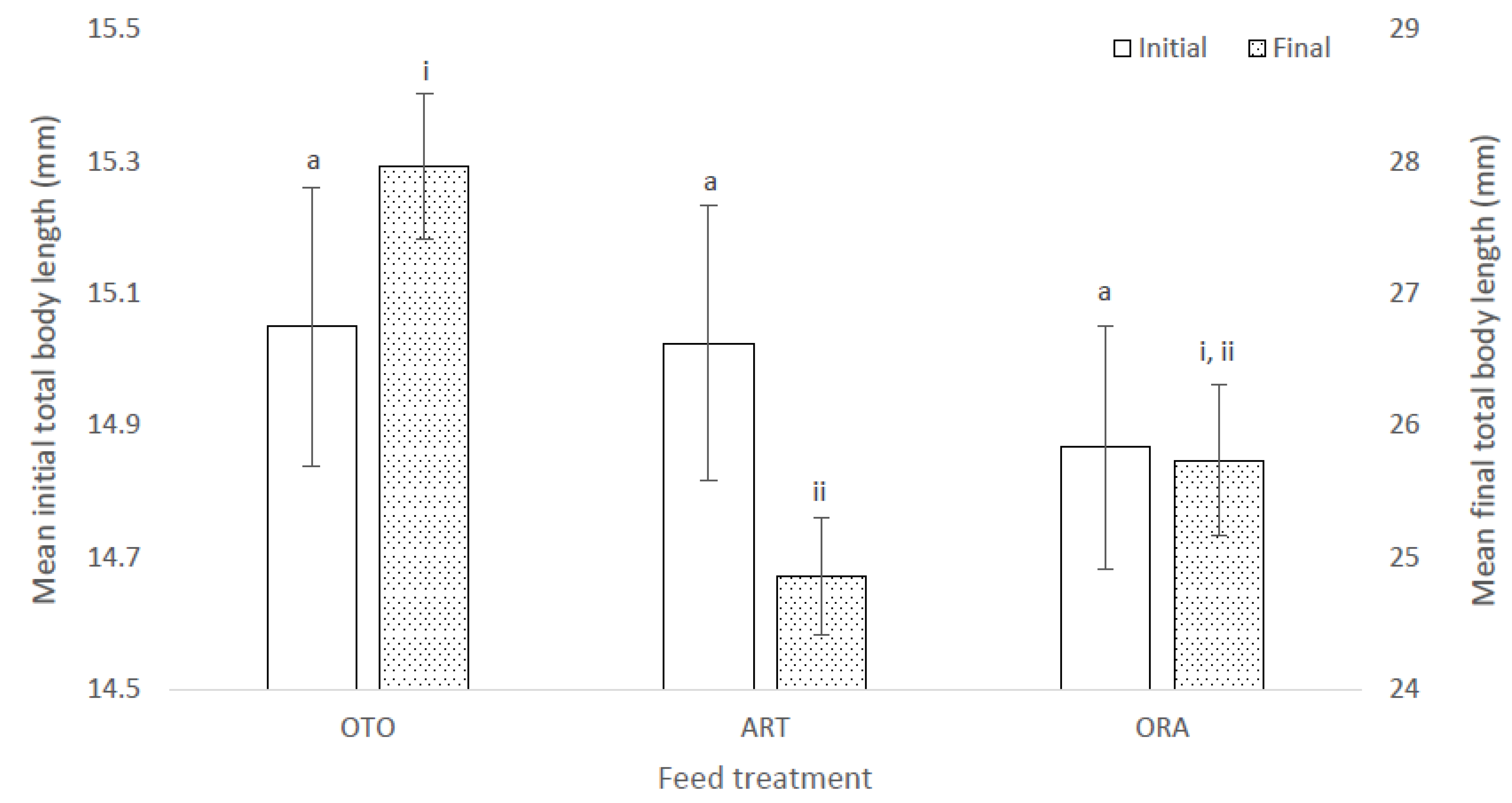
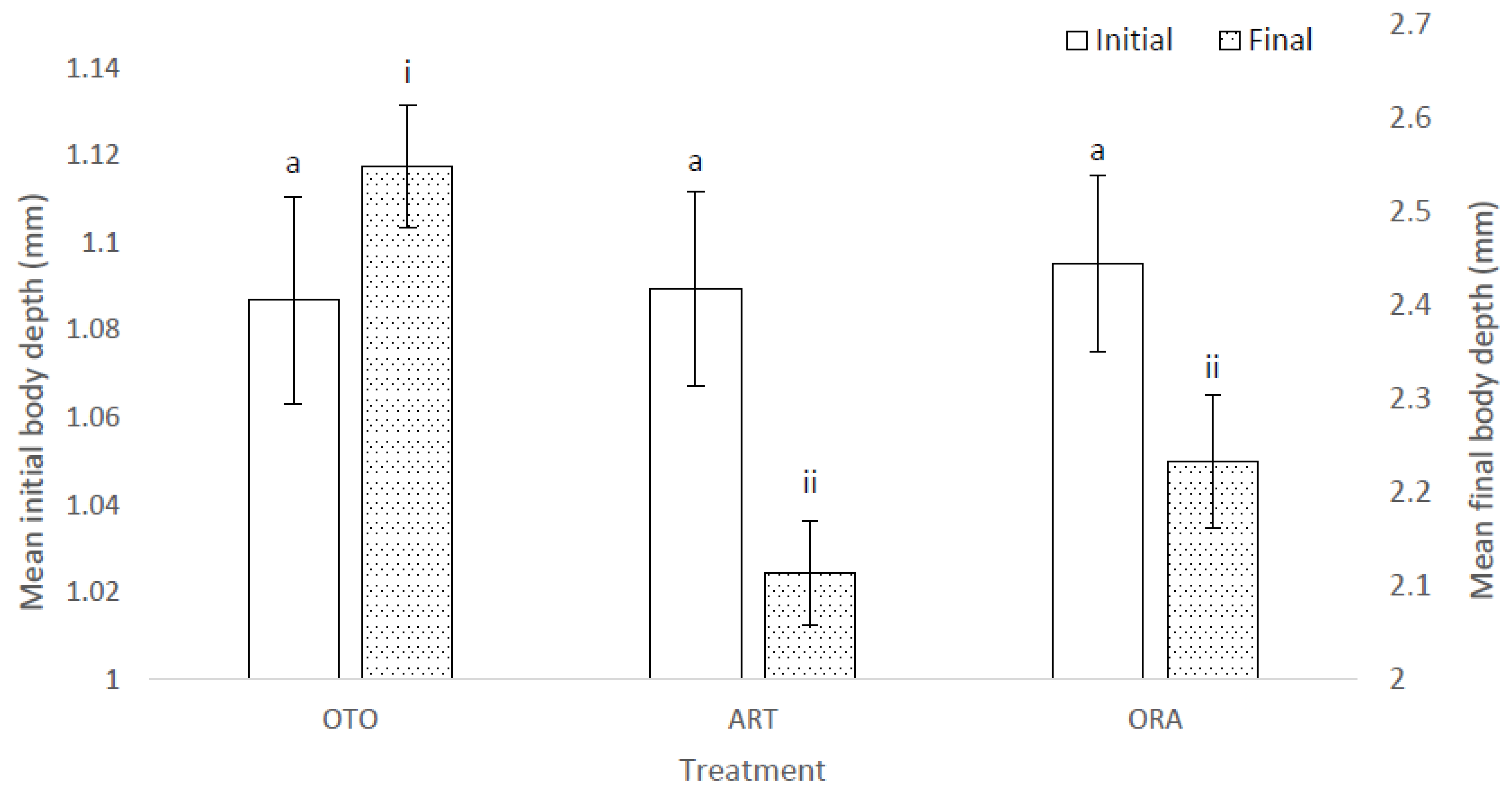
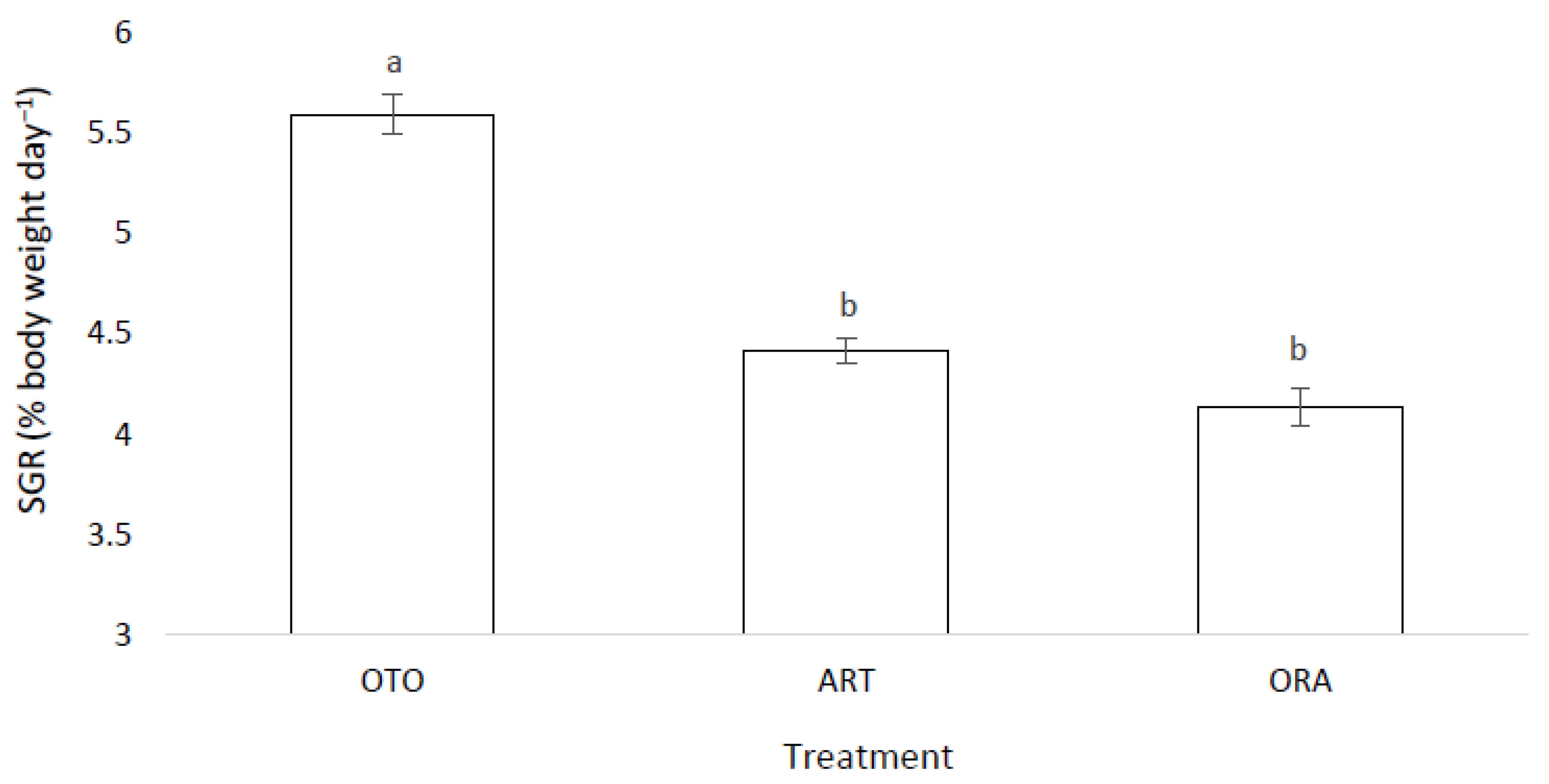

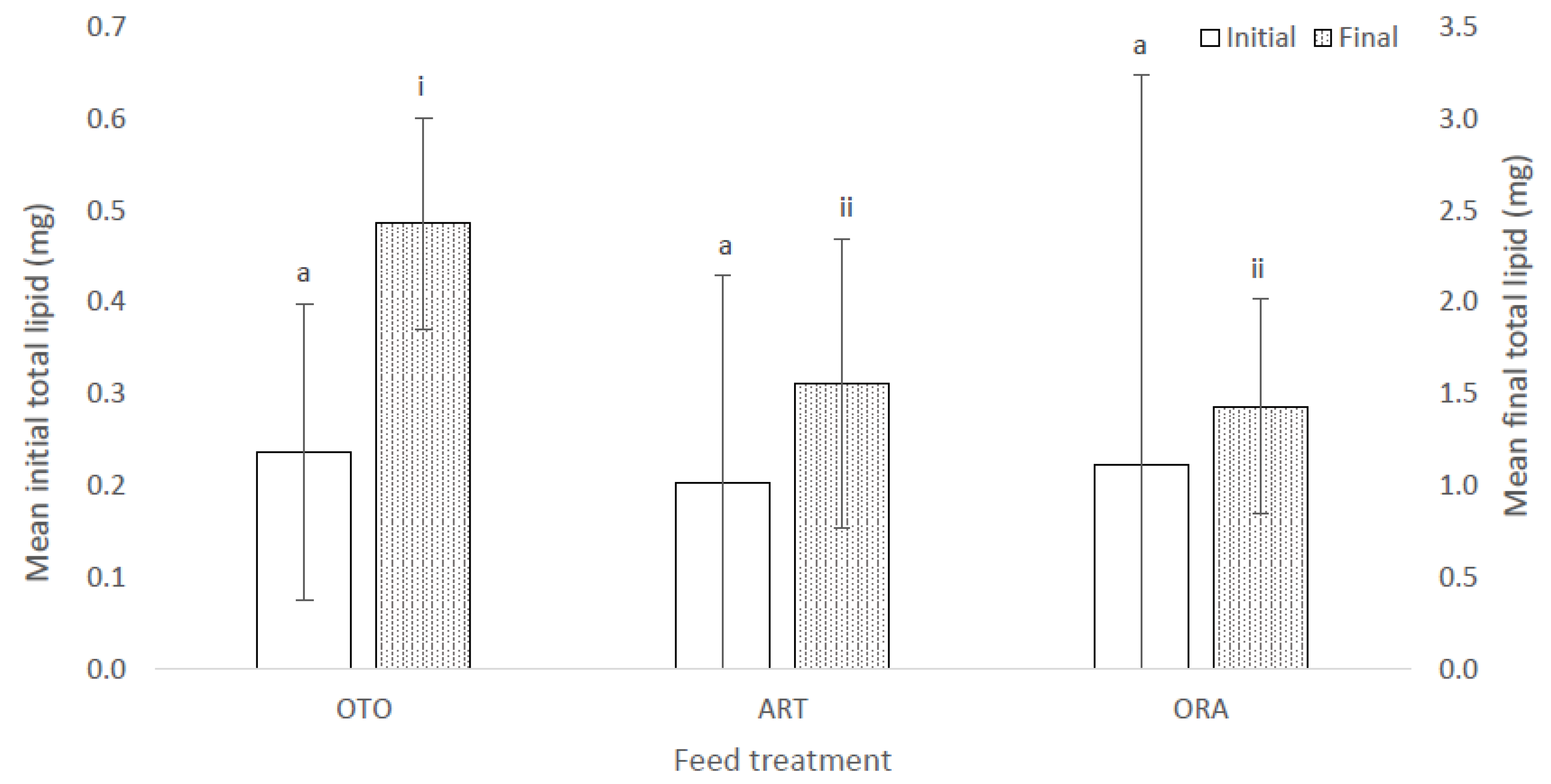
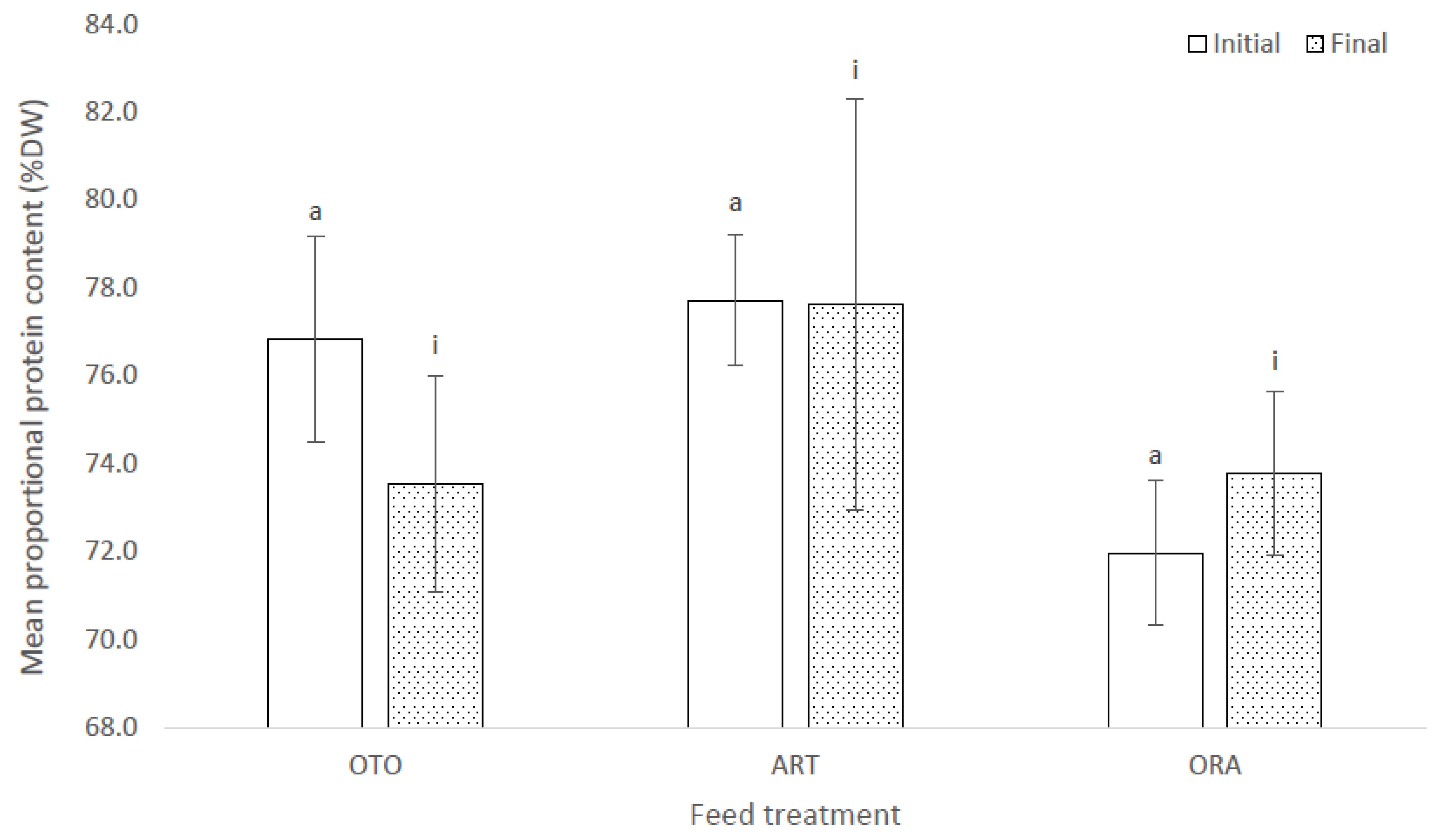

| DAH | Feed | Number of Events |
|---|---|---|
| 0–2 | NIL | - |
| 3–14 | 3 g in-I | 4 |
| 15–21 | 0.1 g SP + 3 g in–II | 4 |
| 22–28 | 0.1 g SP + 2 g in–II | 4 |
| 29–35 | 0.25 g SP + 0.1 g MP + 2 g in–II | 4 |
| 36–44 * | 0.6 g MP | 4 |
| 45–49 | 1.2 g MP | 4 |
| 50–56 | 0.6 g MP | 5 |
| 57–64 | 0.6 g MP + 0.3 g LP | 4 |
| 64–66 | 0.3 g MP + 0.6 g LP | 4 |
| Colour | Protein | Digestible Energy | Gross Energy | Est. Protein:Energy | Lipid | EPA | DHA | ARA | Carbohydrate | Fiber | Ash | Moisture | |
|---|---|---|---|---|---|---|---|---|---|---|---|---|---|
| (% DW) | (kcal/g) | (kcal/g) | (mg/kcal) | (%) | (mg/g) | (mg/g) | (mg/g) | (%DW) | (%DW) | (%DW) | (%DW) | ||
| OTO | Brick Red | 53 | 4.07 | 4.66 | 123 | 9 | 22.9 | 20.3 | 1.1 | 14.5 | 3.5 | 15 | 6.5 |
| ART | Mustard | 57 | 5.01 | 5.50 | 113 | 9 | 11.2 | 12.7 | 0.9 | 12.0 | 2.0 | 5 | 7.0 |
| ORA | Orange | 56 | 4.39 | 5.01 | 124 | 13 | 10.0 | 20.0 | 1.2 | 15.1 | 1.0 | 10 | 5.9 |
| FA | Initial Otohime | Initial Artemac | Initial O.Range | Final Otohime | Final Artemac | Final O.Range |
|---|---|---|---|---|---|---|
| C14:0 | 1.35 ± 0.06 | 1.33 ± 0.07 | 1.48 ± 0.06 | 7.34 ± 0.12 a | 5.47 ± 0.11 b | 3.56 ± 0.08 c |
| C16:0 | 25.92 ± 0.11 | 24.7 ± 0.14 | 25.48 ± 0.1 | 26.82 ± 0.19 a | 25.80 ± 0.16 a | 25.22 ± 0.09 a |
| C16:1n-7c | 1.56 ± 0.03 | 1.60 ± 0.04 | 1.72 ± 0.02 | 2.22 ± 0.08 b | 3.48 ± 0.04 a | 1.55 ± 0.01 c |
| C17:0 | 1.22 ± 0.04 | 1.15 ± 0.05 | 1.23 ± 0.04 | 2.18 ± 0.10 a | 1.07 ± 0.10 b | 0.90 ± 0.04 b |
| C18:0 | 12.95 ± 0.12 | 12.15 ± 0.13 | 12.85 ± 0.16 | 6.33 ± 0.11 a | 7.24 ± 0.14 a | 7.73 ± 0.11 a |
| C18:1n-7t | 3.06 ± 0.07 | 2.93 ± 0.07 | 2.88 ± 0.04 | 1.14 ± 0.10 a | 1.22 ± 0.16 a | 0.90 ± 0.06 a |
| C18:1n-9c | 11.93 ± 0.06 | 12.32 ± 0.07 | 12.06 ± 0.08 | 7.97 ± 0.08 b | 9.64 ± 0.11 a | 7.40 ± 0.04 b |
| C18:2n-6c | 4.07 ± 0.03 | 4.17 ± 0.03 | 4.15 ± 0.02 | 3.47 ± 0.03 c | 4.31 ± 0.03 b | 7.27 ± 0.03 a |
| C18:2n-6t | 4.19 ± 0.03 | 4.30 ± 0.03 | 4.29 ± 0.02 | 3.60 ± 0.03 c | 4.46 ± 0.03 b | 7.43 ± 0.03 a |
| C18:3n-3c | 17.62 ± 0.15 | 17.93 ± 0.14 | 16.69 ± 0.15 | 2.11 ± 0.18 a | 1.85 ± 0.03 a | 2.10 ± 0.03 a |
| C20:1n-9c | 0.41 ± 0.01 | 0.44 ± 0.03 | 0.45 ± 0.01 | 2.04 ± 0.13 a | 2.32 ± 0.20 a | 0.74 ± 0.05 b |
| C20:4n-6c ARA | 1.84 ± 0.03 | 2.00 ± 0.04 | 1.95 ± 0.04 | 1.11 ± 0.03 b | 1.27 ± 0.05 a | 1.33 ± 0.03 a |
| C20:5n-3 EPA | 4.28 ± 0.06 | 4.63 ± 0.07 | 4.36 ± 0.06 | 10.08 ± 0.08 a | 7.73 ± 0.05 b | 7.55 ± 0.06 b |
| C22:1n-9c | 0.34 ± 0.03 | 0.33 ± 0.02 | 0.33 ± 0.02 | 0.96 ± 0.13 b | 2.02 ± 0.21 a | 0.73 ± 0.04 b |
| C22:2n-6c | 2.82 ± 0.04 | 3.07 ± 0.05 | 2.99 ± 0.03 | 5.14 ± 0.08 a | 4.36 ± 0.05 b | 4.19 ± 0.03 b |
| C22:4n-6c | 1.04 ± 0.02 | 1.13 ± 0.03 | 1.09 ± 0.03 | 0.62 ± 0.02 a | 0.48 ± 0.02 b | 0.47 ± 0.01 b |
| C22:5n-3c | 0.48 ± 0.02 | 0.54 ± 0.03 | 0.54 ± 0.03 | 1.77 ± 0.04 b | 1.51 ± 0.03 c | 2.33 ± 0.03 a |
| C22:6n-3c DHA | 0.41 ± 0.05 | 0.71 ± 0.25 | 0.68 ± 0.16 | 11.07 ± 0.08 b | 11.00 ± 0.15 b | 14.86 ± 0.11 a |
| Other | 4.54 ± 0.05 | 4.57 ± 0.05 | 4.78 ± 0.05 | 4.05 ± 0.12 a | 4.77 ± 0.11 a | 3.73 ± 0.05 a |
| Sum PUFA | 37.98 ± 0.13 | 39.86 ± 0.18 | 38.18 ± 0.16 | 40.09 ± 0.08 b | 37.80 ± 0.08 b | 48.19 ± 0.12 a |
| Sum HUFA | 8.27 ± 0.06 | 9.26 ± 0.15 | 8.88 ± 0.12 | 24.76 ± 0.08 b | 22.11 ± 0.11 c | 26.66 ± 0.12 a |
| EPA:ARA | 2.32 ± 0.02 | 2.31 ± 0.01 | 2.23 ± 0.01 | 9.15 ± 0.11 a | 6.13 ± 0.07 b | 5.69 ± 0.03 b |
| DHA:EPA | 0.1 ± 0.03 | 0.15 ± 0.10 | 0.15 ± 0.07 | 1.10 ± 0.04 c | 1.43 ± 0.06 b | 1.97 ± 0.03 a |
| DHA:ARA | 0.23 ± 0.05 | 0.34 ± 0.16 | 0.34 ± 0.11 | 10.10 ± 0.16 a | 8.79 ± 0.18 a | 11.21 ± 0.10 a |
Publisher’s Note: MDPI stays neutral with regard to jurisdictional claims in published maps and institutional affiliations. |
© 2022 by the authors. Licensee MDPI, Basel, Switzerland. This article is an open access article distributed under the terms and conditions of the Creative Commons Attribution (CC BY) license (https://creativecommons.org/licenses/by/4.0/).
Share and Cite
McKay, W.; Jeffs, A. Comparison of Three Artificial Diets for the Larviculture of Giant Kōkopu (Galaxias argenteus). Fishes 2022, 7, 310. https://doi.org/10.3390/fishes7060310
McKay W, Jeffs A. Comparison of Three Artificial Diets for the Larviculture of Giant Kōkopu (Galaxias argenteus). Fishes. 2022; 7(6):310. https://doi.org/10.3390/fishes7060310
Chicago/Turabian StyleMcKay, William, and Andrew Jeffs. 2022. "Comparison of Three Artificial Diets for the Larviculture of Giant Kōkopu (Galaxias argenteus)" Fishes 7, no. 6: 310. https://doi.org/10.3390/fishes7060310
APA StyleMcKay, W., & Jeffs, A. (2022). Comparison of Three Artificial Diets for the Larviculture of Giant Kōkopu (Galaxias argenteus). Fishes, 7(6), 310. https://doi.org/10.3390/fishes7060310







